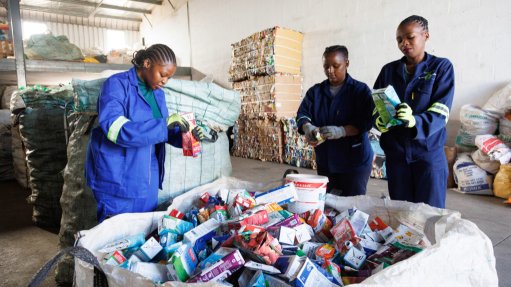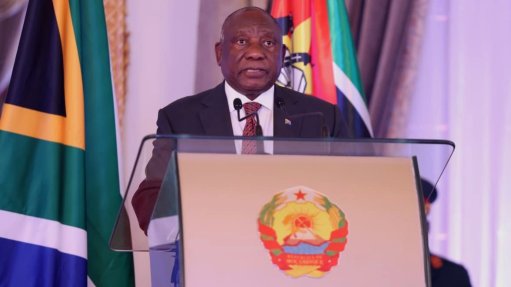Large-scale oil, gas comeback for Angola
Recent deepwater discoveries and fiscal policy improvements have contributed to a significant uptick in investments in Angola’s oil and gas industry, says energy advocacy group African Energy Chamber executive chairperson NJ Ayuk.
He explains that international oil companies are driving multiple exploration and production projects including Kaombo North, the Eastern and Western hubs at Block 15/06 operated by oil and gas company Eni Angola, as well as CLOV Phase Two and Dalia Phase Three at Block 17 operated by multienergy company TotalEnergies.
Additionally, earlier this year, Angola surpassed Nigeria as the top oil-producing country in Africa. In April, Angola produced 1.06-million barrels a day of crude oil, while Nigeria and Algeria both produced 990 000 bbl/d.
However, Ayuk notes that while the outlook for Angola’s upstream industry is more than optimistic, the country’s downstream sector still has some way to go.
Currently, Angola’s sole operational refinery is the Luanda Refinery, in Luanda, which has only been able to meet 20% of the country’s demand for refined products.
Ayuk explains that as a result of this lack of infrastructure, Angola spends over $1.7-billion yearly on oil imports despite vast petroleum reserves totalling about nine-billion barrels of oil and 11-trillion cubic feet of natural gas.
Despite this, he says that the outlook is promising. Angolan President João Lourenço and Mineral Resources, Oil and Gas Minister Diamantino Azevedo have made strengthening the country’s oil and gas refining capacity a priority, he explains.
Ayuk explains that Lourenço and Azevedo’s objectives are to meet domestic energy demand, reduce oil imports and maximise the monetisation of energy resources for regional and global markets.
These efforts started showing promising results from the offset in 2022, when Angola expanded the Luanda Refinery in cooperation with Italian oil major Eni increasing the plant’s daily production to 1 200 t/d.
Further, several new facilities, namely the Cabinda, Soyo and Lobito refineries, are in the works, Ayuk explains.
Refineries in Development
Phase 1 of the Cabinda refinery — a 30 000 bbl/d crude unit that produces diesel, heavy fuel, jet fuel and naphtha — is expected to be operational in mid-2024. Cabinda’s capacity will double to 60 000 bbl/d when the final phase of construction is completed, says Ayuk.
As recently as this month, Africa Finance Corporation and African Export-Import Bank announced a $335-million credit facility for the project, which will cover the first phase of construction. The refinery is being developed by emerging markets asset manager Gemcorp Holding in partnership with Angola’s national oil company Sonangol.
The Soyo refinery project is scheduled to be completed in 2025. Angola’s Ministry of Mineral Resources and Petroleum awarded the tender for the construction of the 100 000-bbl/d refinery in Soyo to US-based developer Quanten Consortium Angola.
The consortium will design, build-to-own, and operate the deep-conversion refinery. In addition to the refinery, Quanten will develop a tank farm, marine terminal and infrastructure in the area.
Further, a 200 000-bbl/d refinery in Lobito province is being developed, with services provided by Japanese conglomerate JGC Holdings. Sonangol has signed a memorandum of understanding (MoU) with large-scale engineering group China National Chemical Engineering (CNCEC) for the construction of the refinery.
The MoU aims to secure financing for the project and may lead to a contract for construction by CNCEC. The refinery, expected to be operational by 2026, will have a capacity to produce up to 200 000 bbl/d.
A New Era for Angola
In 2022, Azevedo said that building refineries and modernising the existing one would allow Angola to sustain its energy supply and reduce the steep costs associated with energy imports, Ayuk explains.
He adds that Azevedo and Lourenço have continued to move the country closer to realising those benefits among others.
Scaling up its refining capacity will enable Angola to maximise the monetisation of its energy resources, he says.
With new projects like Eni’s Ndungu Early Production Project and TotalEnergies’ CLOV floating production, storage and offloading unit, Angola aims to trade ready-to-use fuels with Europe, reducing Europe’s reliance on Russian resources.
Further, downstream activities such as marketing and distribution will set the stage for job creation and business opportunities, from running service stations to supplying lubricant oils.
Additionally, Ayuk emphasises that Angola will be better positioned to meet regional energy demands.
As more refineries come online, Angola can make use of such cross-border trade systems as the Central African Pipeline System and the Angola-Zambia pipeline to deliver refined products to other African countries.
Promising Initiatives
Ayuk says that driving growth in Angola’s downstream sector is one example of the steps Angola’s government has taken to strengthen the country’s energy industry.
The Angolan government has implemented extensive reforms including offering fiscal incentives for the development of marginal oil fields, establishing regulations for well abandonment and decommissioning, and enacting the first natural gas law.
“The African Energy Chamber sees [these] efforts as major wins for Angola that will help ensure ongoing foreign investment, energy security and economic growth,” Ayuk concludes.
Article Enquiry
Email Article
Save Article
Feedback
To advertise email advertising@creamermedia.co.za or click here
Comments
Press Office
Announcements
What's On
Subscribe to improve your user experience...
Option 1 (equivalent of R125 a month):
Receive a weekly copy of Creamer Media's Engineering News & Mining Weekly magazine
(print copy for those in South Africa and e-magazine for those outside of South Africa)
Receive daily email newsletters
Access to full search results
Access archive of magazine back copies
Access to Projects in Progress
Access to ONE Research Report of your choice in PDF format
Option 2 (equivalent of R375 a month):
All benefits from Option 1
PLUS
Access to Creamer Media's Research Channel Africa for ALL Research Reports, in PDF format, on various industrial and mining sectors
including Electricity; Water; Energy Transition; Hydrogen; Roads, Rail and Ports; Coal; Gold; Platinum; Battery Metals; etc.
Already a subscriber?
Forgotten your password?
Receive weekly copy of Creamer Media's Engineering News & Mining Weekly magazine (print copy for those in South Africa and e-magazine for those outside of South Africa)
➕
Recieve daily email newsletters
➕
Access to full search results
➕
Access archive of magazine back copies
➕
Access to Projects in Progress
➕
Access to ONE Research Report of your choice in PDF format
RESEARCH CHANNEL AFRICA
R4500 (equivalent of R375 a month)
SUBSCRIBEAll benefits from Option 1
➕
Access to Creamer Media's Research Channel Africa for ALL Research Reports on various industrial and mining sectors, in PDF format, including on:
Electricity
➕
Water
➕
Energy Transition
➕
Hydrogen
➕
Roads, Rail and Ports
➕
Coal
➕
Gold
➕
Platinum
➕
Battery Metals
➕
etc.
Receive all benefits from Option 1 or Option 2 delivered to numerous people at your company
➕
Multiple User names and Passwords for simultaneous log-ins
➕
Intranet integration access to all in your organisation


















